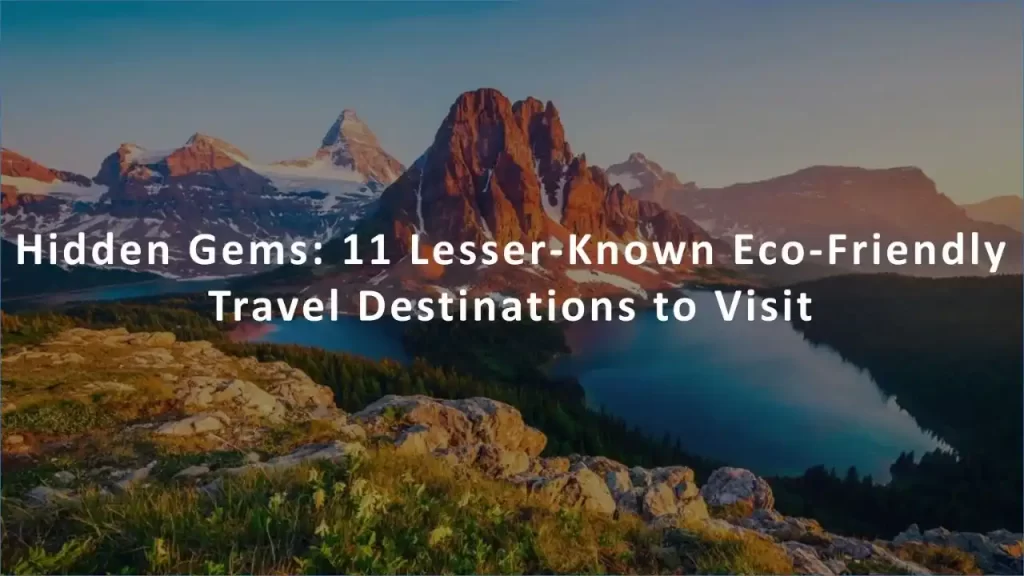Tired of the usual tourist hubs? Ready for a new kind of travel? Say hello to eco-friendly travel destinations!
Step off the crowded path and into a world where nature and culture thrive hand in hand. Here, sustainability isn’t a trend; it’s a lifestyle.
This isn’t your ordinary travel guide. We won’t steer you to the typical landmarks. Instead, we invite you to explore lesser-known, sustainable havens where clear waters meet untouched shores and communities embrace eco-living.
Come along as we unveil these eco-travel secrets, where every step makes a positive mark. Your journey starts here, among these hidden eco-friendly treasures.
You May Also Read: What is Sustainable Travel (HOW TO DO IT – 13 Proven Ways)
1. Drake Bay, Costa Rica
Costa Rica, a small country with an enormous reputation for ecotourism, beckons you to discover its eco-paradise, starting with the captivating Drake Bay.
Here, over a quarter of the nation’s land is dedicated to national parks, nature reserves, and conservation initiatives.

Why Drake Bay?
Nestled on the northern end of the breathtaking Osa Peninsula, Drake Bay is your gateway to the Corcovado National Park, a UNESCO World Heritage Site celebrated for its diverse ecosystems.
The park encompasses 13 distinct ecological zones across 164 miles, offering a mesmerizing tapestry of natural wonders.
Suggested Eco-Friendly Activities:
- Corcovado Wildlife Safaris: Embark on guided wildlife safaris within the Corcovado National Park to witness Costa Rica’s remarkable biodiversity. Encounter howler monkeys, scarlet macaws, and elusive jaguars in their natural habitat.
- Kayak and Snorkel Expeditions: Explore the pristine coastal waters surrounding Drake Bay on guided kayak and snorkelling tours. Discover vibrant coral reefs, sea turtles, and a kaleidoscope of marine life beneath the waves.
- Canopy Tours: Glide through the treetops on exhilarating canopy tours, offering bird’s-eye views of the lush rainforest. Keep an eye out for toucans, sloths, and other canopy-dwelling creatures.
- Cultural Encounters: Engage with the local community to learn about their sustainable living practices. Visit indigenous villages, support local artisans, and savor traditional Costa Rican cuisine.
You May Also Read: Earth Harmony Living: A Complete Guide
- Hiking Adventures: Embark on scenic hikes through the Osa Peninsula’s rich rainforests and coastal trails. Explore hidden waterfalls, swim in pristine rivers, and immerse yourself in the region’s natural beauty.
- Nighttime Wildlife Tours: Experience the magic of nocturnal wildlife on guided night tours. Witness bioluminescent organisms, tree frogs, and other creatures that come to life after sunset.
Drake Bay epitomizes the essence of sustainable travel, where every adventure contributes to the preservation of Costa Rica’s ecological wonders.
It’s a place where exploration and conservation walk hand in hand, inviting you to be a part of this remarkable eco-journey.
You May Also Read: 5 Top-rated Solar Panels for RV: A Beginner’s Guide
2. Northern Pakistan (Gilgit-Baltistan)
Next on the list of eco-friendly travel destinations, we have Northern Pakistan.
Nestled in the heart of the mighty Himalayas, Karakoram, and Hundu Kush, Gilgit-Baltistan in northern Pakistan is a land of remarkable cultural diversity and breathtaking landscapes.
What sets it apart is not just its stunning natural beauty but also the warmth and tolerance of its people.
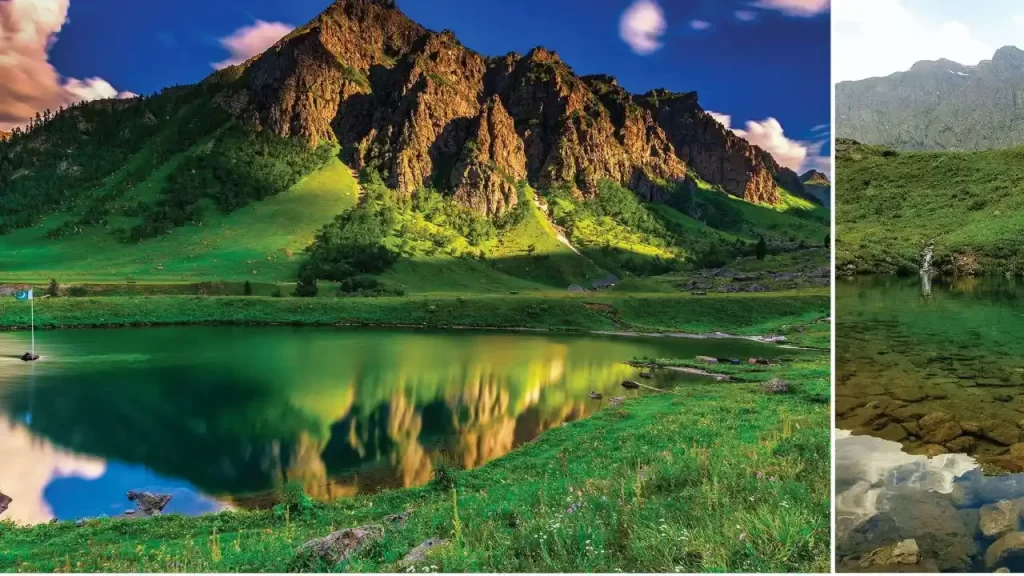
Why Gilgit-Baltistan?
Gilgit-Baltistan is a tapestry of culture and natural splendor.
Its cultural diversity, tolerance among its people, and magnificent natural attractions make it an ideal destination for eco-conscious travelers.
Suggested Eco-Friendly Activities:
- Cultural Immersion: Engage with the diverse ethnic groups of Gilgit-Baltistan, including the Brusho People, Baltis, Wakhi, and Shinaki. Participate in local festivals, visit ancient forts, and embrace their rich cultural heritage.
- Local Cuisine Exploration: Savor traditional dishes like “Chapshuro,” “Giyalching/Giyaling,”, Harisa/Lajak, and “Dawdaw.” Support local eateries and indulge in authentic flavors while contributing to the community.
- Mountain Adventures: Explore the majestic Himalayan peaks, including the legendary K2. Hiking, trekking, and mountaineering opportunities abound, offering unforgettable experiences amid these colossal giants.
- Lakes and Rivers: Discover pristine lakes such as Karambar Lake, Baro Sar Birgal Ghizer, khalti Lake, Attabad Lake and enjoy boating or fishing. Embrace the tranquility of the region’s serene rivers and engage in water-based activities.
- Karakoram Highway Journey: Embark on a scenic journey along the Karakoram Highway, marveling at its dramatic landscapes and the human engineering feat that connects Pakistan to China.
- Language and Culture: Engage with locals, learn about their diverse languages, and immerse yourself in their cultural tapestry. Building connections with people is an enriching eco-friendly experience.
- Winter Sports: In the winter months, embrace the thrill of skiing and ice hockey in the region’s beautiful resorts, like Naltar.
- Exploring Historical Sites: Visit ancient forts like Baltit Fort and Altit Fort, uncover petroglyphs and rock art, and witness vibrant festivals like the Shandoor Polo Festival.
Gilgit-Baltistan is an eco-traveler’s dream, where cultural diversity and natural beauty merge harmoniously.
By engaging in these eco-friendly activities, you not only experience the wonders of this region but also contribute positively to its sustainable tourism efforts.
You May Also Read: 27 Best Eco Friendly Travel Products
3. Haukland Beach, Norway
Nestled along the dramatic Norwegian coastline, Haukland Beach is a hidden gem renowned for its pristine beauty.
Its inclusion on this list is a testament to its eco-friendly charm and breathtaking landscapes.
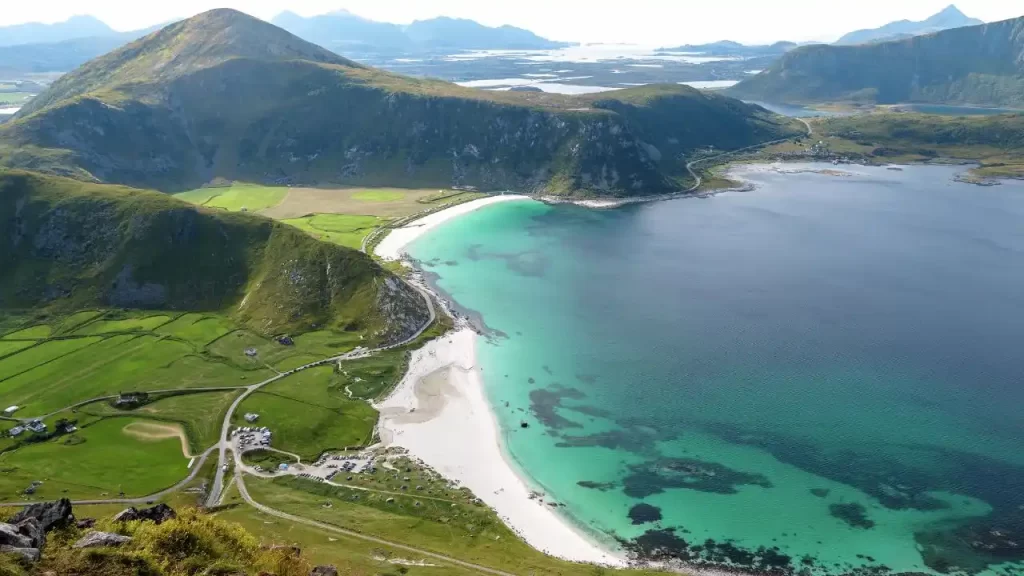
Image credit: Visit Lofoten
Why Haukland Beach?
Haukland Beach is a paradise for nature enthusiasts, offering a serene escape where turquoise waters meet powdery white sands.
Its untouched beauty and commitment to environmental preservation make it an ideal choice for eco-conscious travelers.
Suggested Eco-Friendly Activities:
- Beach Cleanups: Join local initiatives or organize your own beach cleanup to contribute to the preservation of this natural haven. Every effort counts in maintaining the beach’s pristine condition.
- Hiking Adventures: Explore the surrounding landscapes on scenic hikes. Trails lead to stunning viewpoints, where you can witness the beauty of the Lofoten Islands and capture unforgettable moments.
- Wildlife Watching: Keep an eye out for the rich birdlife and marine creatures that call this area home. Seals, seabirds, and even whales can often be spotted along the coastline.
- Photography and Stargazing: Capture the mesmerizing landscapes of Haukland Beach, both during the day and at night. The dark skies offer excellent opportunities for stargazing and Northern Lights photography.
You May Also Read: 5 Best Mini Drones That Will Blow Your Mind: Your Ultimate Guide
- Responsible Camping: Experience the beach’s natural beauty through responsible camping. Campfires are prohibited, so opt for eco-friendly camping practices and leave no trace of your visit.
- Kayaking and Snorkeling: Explore the crystal-clear waters of Haukland Beach through kayaking or snorkeling. Witness the vibrant underwater world while respecting the fragile marine ecosystem.
- Support Local Businesses: Contribute to the local economy by dining at nearby restaurants and trying fresh seafood dishes. Choose establishments that prioritize sustainability and use locally sourced ingredients.
Haukland Beach invites you to unwind in its unspoiled beauty and engage in eco-friendly activities that celebrate its natural splendor.
By treading lightly and embracing responsible practices, you can ensure that this coastal treasure remains a haven for generations to come.
4. Stuðlagil Canyon, Iceland
Tucked away in the heart of Iceland’s rugged wilderness, Stuðlagil Canyon stands as a geological wonder.
Its inclusion on this list stems from its unique natural beauty and its status as an emerging eco-friendly destination.

Why Stuðlagil Canyon?
Stuðlagil Canyon offers a glimpse into Iceland’s geological history.
The striking basalt column formations and pristine glacial river that runs through it make it a site of great geological significance, drawing eco-conscious travelers seeking a deep connection with nature.
Suggested Eco-Friendly Activities:
- Guided Canyon Tours: Explore the canyon with experienced local guides who can lead you safely through this delicate environment. They can also share insights into the canyon’s formation and ecological importance.
- Respectful Photography: Capture the canyon’s beauty through photography but do so with respect for the fragile terrain. Stick to designated paths and viewpoints to avoid causing damage to the natural formations.
- Hiking and Birdwatching: Enjoy the surrounding hiking trails that lead to panoramic views of the canyon and the Jökulsá á Dal River. Keep an eye out for the diverse birdlife that inhabits the area.
- Leave No Trace Camping: If you plan to camp near Stuðlagil Canyon, adhere to Leave No Trace principles. Ensure that your camping practices have minimal impact on the environment.
- Geological Education: Engage in the educational opportunities offered by local organizations. Learn about the geological history of the canyon and how it was formed over centuries.
- Support Local Conservation: Contribute to the conservation efforts of local organizations that aim to protect Stuðlagil Canyon and its surroundings. Your support helps ensure the preservation of this unique site.
Stuðlagil Canyon invites you to unravel the mysteries of its geological wonders while embracing eco-friendly practices.
By immersing yourself in its natural beauty and respecting its fragility, you can play a vital role in preserving this Icelandic treasure for future generations.
5. Hanging Tiger’s Nest, Paro Bhutan
Perched dramatically on the edge of a cliff in the Paro Valley, Bhutan’s Tiger’s Nest Monastery is an architectural marvel and a spiritual sanctuary.
Its inclusion on this list of eco-friendly travel destinations is a testament to its cultural significance and the sustainable practices it upholds.

Why Tiger’s Nest?
Tiger’s Nest Monastery, or Paro Taktsang, holds a special place in Bhutanese culture and Buddhism.
Its stunning location and commitment to sustainable tourism make it an ideal destination for eco-conscious travelers seeking spirituality and natural beauty.
Suggested Eco-Friendly Activities:
- Hiking Pilgrimage: Embark on a scenic hike to Tiger’s Nest, following well-maintained trails. The journey itself is a spiritual and eco-friendly experience, offering breathtaking views of the Himalayas.
- Cultural Immersion: Engage with local monks and immerse yourself in the spiritual ambiance of the monastery. Attend prayer sessions and learn about Bhutanese Buddhism and culture.
- Photography with Care: Capture the iconic views of Tiger’s Nest but do so respectfully. Follow the photography guidelines and avoid intrusive behavior to maintain the sanctity of the site.
- Responsible Souvenir Shopping: Support local artisans by purchasing handmade souvenirs from the nearby stalls. Choose products that reflect Bhutanese craftsmanship and culture.
- Waste Reduction: Carry reusable water bottles and snacks to minimize single-use plastics. Dispose of waste responsibly in designated bins and respect the “No Littering” policy.
- Respect for Sacred Sites: When inside the monastery, adhere to the dress code and maintain a respectful demeanor. Photography is usually prohibited inside religious chambers.
- Eco-Friendly Accommodations: Stay in eco-friendly accommodations in Paro, which prioritize sustainability and contribute positively to the local economy.
Tiger’s Nest Monastery is more than a physical structure; it’s a symbol of Bhutan’s deep spirituality and commitment to preserving its natural and cultural heritage.
By visiting this sacred site with reverence and engaging in eco-friendly practices, you can truly connect with the heart of Bhutan.
6. Slovenia
Nestled in the heart of Europe, Slovenia offers a captivating blend of natural beauty, cultural richness, and eco-conscious living.
Its inclusion on this list is a nod to its lesser-known but equally stunning destinations and its commitment to sustainable tourism.
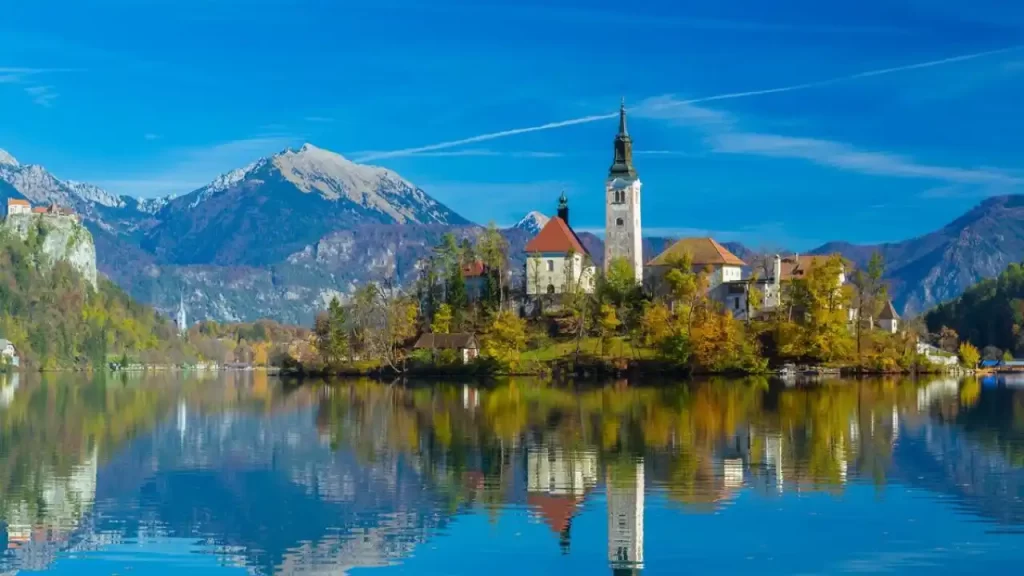
Why Slovenia?
Beyond the well-trodden paths of Ljubljana, Bled, and Piran, Slovenia boasts a treasure trove of hidden gems.
Its pristine landscapes, charming villages, and dedication to environmental conservation make it a must-visit for eco-conscious travelers.
Suggested Eco-Friendly Activities:
- Jezersko: Explore the tranquility of Jezersko, a pristine alpine valley. Enjoy hiking, cycling, and birdwatching while immersing yourself in the serene natural surroundings.
- Radovljica: Discover the historical charm of Radovljica, a town filled with medieval architecture and delightful old-town charm. Support local businesses and indulge in traditional cuisine.
- Kranj: Dive into the vibrant culture of Kranj, with its rich history and artistic spirit. Visit museums, galleries, and take leisurely strolls along the scenic riverbanks.
- Bohinj with Savica Waterfall: Marvel at the breathtaking beauty of Bohinj, home to pristine Lake Bohinj and the captivating Savica Waterfall. Hike around the lake and explore the surrounding forests.
- Mountain Adventures: If you’re well-prepared, take on the challenge of Slovenia’s spectacular mountains. Trekking, mountaineering, and alpine experiences await those seeking adventure.
- Zelenci near Kranjska Gora: Witness the stunning Zelenci Nature Reserve, known for its emerald green lake and unique wetland ecosystem. Birdwatchers will be in awe of the diverse avian population.
- Tamar Valley: Delve into the tranquility of the Tamar Valley, a haven for hiking and outdoor enthusiasts. Immerse yourself in unspoiled nature while respecting the delicate ecosystem.
- Celje Castle: Explore the historic Celje Castle, a medieval fortress with captivating exhibitions and panoramic views of the surrounding landscapes.
- Trenta Valley: Traverse the Trenta Valley, known for its captivating scenery and botanical diversity. Discover the region’s rich natural heritage through educational trails.
- The Path to Belvedere above Izola: Embark on a picturesque hike to the Belvedere viewpoint above Izola, offering stunning vistas of the Adriatic Sea and the surrounding coastline.
- Amazing Caves: Explore Slovenia’s remarkable underground world by visiting famous caves such as Postojna Cave, Škocjan Caves, and the lesser-known but equally impressive Krizna Cave.
Slovenia’s charm lies not just in its renowned destinations but also in its hidden treasures.
By venturing beyond the tourist hotspots and embracing eco-friendly activities, you can uncover the country’s true essence and contribute to its sustainable tourism efforts.
You May Also Read: Survival 101: The Ultimate Guide to Solar Generators for Emergencies
7. Pula, Croatia
Nestled on the pristine shores of the Adriatic Sea, Pula in Croatia is a captivating blend of history, culture, and natural beauty. Its inclusion on this list celebrates its unique charm, international appeal, and the remarkable Roman Amphitheatre.
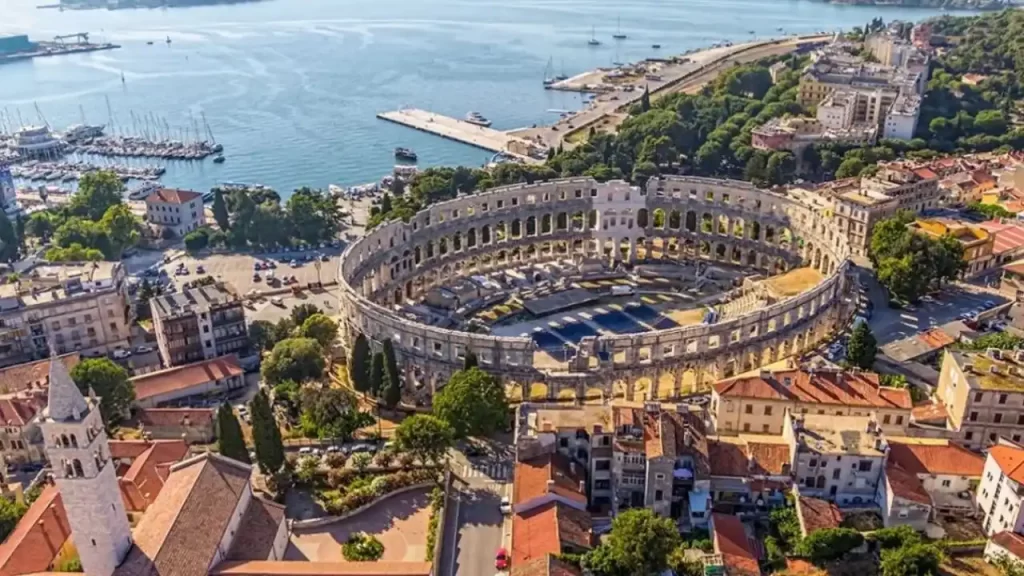
Why Pula?
Pula’s allure lies not only in its stunning waterfront setting but also in its rich history as an important marine port during the Austro-Hungarian monarchy.
This coastal city offers a delightful blend of tradition and international significance.
Suggested Eco-Friendly Activities:
- Roman Amphitheatre: Stand in awe of the breathtaking Roman Amphitheatre, one of the best-preserved ancient arenas in the world. Explore its history and take in its grandeur.
- Exploring Pula: Wander through Pula’s picturesque streets, adorned with charming architecture and a laid-back Mediterranean atmosphere. Visit local markets, cafes, and historic sites.
- Maritime Heritage: Explore Pula’s maritime heritage by visiting the Naval Cemetery and the Shipyard Uljanik, which played a crucial role during the Austro-Hungarian era.
- Cultural Festivals: Check the local events calendar for cultural festivals, music concerts, and film screenings. Pula’s cultural scene is vibrant and diverse.
- Cuisine: Savor the flavors of Istrian cuisine at local restaurants and konobas. Try traditional dishes like Istrian truffle pasta and fresh seafood while supporting the local culinary scene.
- Nature and Beaches: Discover Pula’s natural beauty by hiking in protected areas like Rt Kamenjak or relaxing on the city’s pristine beaches. Choose eco-friendly beach practices to protect the coastline.
By appreciating its cultural heritage and embracing sustainable practices, you can experience the city’s timeless charm while contributing to its eco-friendly ethos.
8. Galápagos Islands, Ecuador
The Galápagos Islands, an ecological wonderland, is a must-visit for travelers seeking unparalleled biodiversity and pristine landscapes.
Their inclusion on this list acknowledges their role as a cradle of evolution and the ongoing conservation efforts.

Image credit: Worldatlas
Why Galápagos Islands?
The Galápagos Islands, with their unique wildlife and breathtaking landscapes, offer an extraordinary opportunity to witness nature’s wonders up close.
These islands are at the forefront of sustainable tourism and conservation.
Suggested Eco-Friendly Activities:
- Wildlife Encounters: Explore the islands with naturalist guides to witness the incredible wildlife, including giant tortoises, marine iguanas, and blue-footed boobies.
- Snorkeling and Diving: Immerse yourself in the underwater world of the Galápagos. Snorkeling and diving excursions allow you to observe diverse marine life, including sharks, sea lions, and colorful fish.
- Hiking Adventures: Embark on guided hikes to observe unique flora and fauna. Visit volcanic landscapes, lava tunnels, and pristine beaches while following Leave No Trace principles.
- Conservation Initiatives: Learn about the Galápagos National Park’s conservation efforts and how you can contribute to protecting this fragile ecosystem.
- Sustainable Cruises: Choose eco-friendly cruise operators that prioritize responsible tourism practices, including waste reduction and wildlife protection.
The Galápagos Islands are a testament to the wonders of nature and the importance of conservation.
By engaging in eco-friendly activities, you can experience this naturalist’s paradise while supporting its sustainable future.
You May Also Read: Jackery Solar Generators Reviews: Jackery 2000 Pro, 1500, and More
9. British Columbia, Canada
British Columbia, Canada’s western gem, is a sprawling landscape of diverse ecosystems, from lush rainforests to rugged mountains.
Its inclusion on this list celebrates its commitment to eco-tourism and the preservation of its stunning natural beauty.

Why British Columbia?
British Columbia boasts an impressive natural playground that encompasses rugged mountains, pristine forests, coastal wonders, and vibrant cities.
Its dedication to preserving its natural beauty and embracing eco-tourism makes it an ideal destination for those seeking adventure and environmental consciousness.
Suggested Eco-Friendly Activities:
- Outdoor Adventures: Embark on outdoor escapades such as hiking, biking, and kayaking in BC’s national parks, including Pacific Rim National Park Reserve and Yoho National Park.
- Wildlife Encounters: Seek out opportunities to witness British Columbia’s diverse wildlife, including grizzly bears, whales, eagles, and salmon. Join responsible wildlife-watching tours for unforgettable experiences.
- Indigenous Cultural Experiences: Connect with the indigenous cultures of BC through guided tours, art galleries, and cultural events. Learn about the rich heritage and traditions of First Nations communities.
- Sustainable Accommodations: Stay at eco-friendly lodges and resorts that emphasize sustainability, conservation, and reducing their carbon footprint.
- Farm-to-Table Dining: Savor locally sourced cuisine at farm-to-table restaurants and support sustainable agriculture in the region.
- Wine and Craft Beer Tasting: Explore BC’s burgeoning wine regions and craft breweries, where you can indulge in tastings while enjoying scenic vineyard landscapes.
- Conservation Initiatives: Participate in volunteer programs and conservation initiatives that contribute to preserving BC’s natural ecosystems.
British Columbia invites you to explore its vast natural wonders while embracing eco-friendly practices.
By treading lightly and supporting sustainable tourism, you can fully experience the province’s diverse landscapes and contribute to its environmental stewardship.
10. Vardzia, Georgia
For history enthusiasts and adventurers alike, Vardzia in southern Georgia stands as an awe-inspiring testament to ancient civilization and architectural marvels.

Why Vardzia?
Vardzia, an ancient cave city from the 12th century, offers an immersive journey into Georgia’s remarkable history.
Carved into the mountainside, it served as a cultural center and monastery.
This extraordinary site is an ode to Georgia’s enduring past.
Suggested Eco-Friendly Activities:
- Exploring Vardzia Monastery: Venture into the labyrinthine tunnels and chambers of Vardzia, where you can discover over 600 storage rooms, including dining areas, pantries, and cellars filled with historical relics.
- Hiking and Trekking: Explore the surrounding natural beauty with hikes and treks that lead to panoramic views of the rugged landscapes and the Kura River.
- Vardzia Cave Exploration: Visit the nearby Vardzia Cave, believed to have been a refuge for King Giorgi III of Georgia. Marvel at the ancient rock-cut chambers and passages.
- Cultural Discovery: Engage with local guides and historians to learn about Vardzia’s cultural significance and the history of Georgia during the 12th century.
- Responsible Tourism: Respect the fragile archaeological site by following guidelines for preserving its integrity. Leave no trace and minimize your impact on the historical structures.
Vardzia, with its intricate cave city and deep-rooted history, invites you to step back in time and uncover the secrets of ancient Georgia.
By immersing yourself in its rich past and embracing eco-friendly practices, you can connect with the heritage of this remarkable destination.
11. South Island, New Zealand
New Zealand’s South Island is renowned for its breathtaking landscapes, and the countless stunning waterfalls that adorn this natural wonderland.
From cascading giants to hidden gems, South Island’s waterfalls are a testament to the raw beauty of nature.
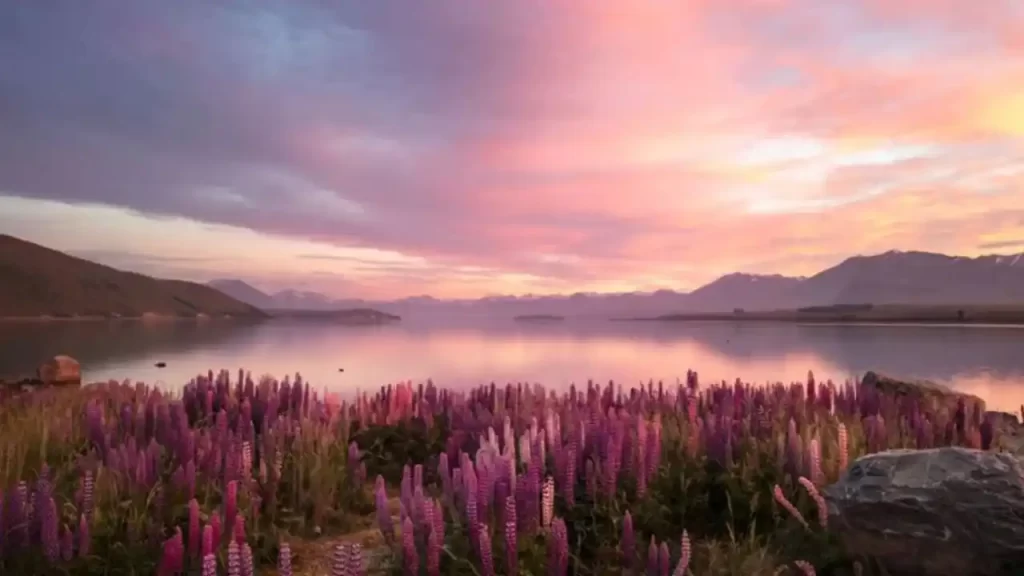
Why South Island?
South Island’s majestic waterfalls offer a captivating spectacle, enriching the region’s diverse natural beauty.
Each waterfall is a unique masterpiece, from thunderous giants to tranquil cascades, making it a must-visit destination for nature enthusiasts.
Suggested Eco-Friendly Activities:
- Waterfall Exploration: Embark on a waterfall-hunting adventure across South Island, where you can witness the awe-inspiring beauty of falls like Milford Sound’s Bowen Falls and the enchanting Purakaunui Falls.
- Hiking Adventures: Discover waterfalls along scenic hiking trails, such as the Hooker Valley Track, where you can marvel at the majestic Mount Cook and the Mueller Glacier.
- Photography: Capture the magic of South Island’s waterfalls through photography, taking in the play of light and water amidst the pristine landscapes.
- Wildlife Encounters: Keep an eye out for native wildlife as you explore the lush rainforests and alpine meadows surrounding the waterfalls.
- Responsible Travel: Adhere to Leave No Trace principles and protect these fragile environments by staying on designated paths and respecting local conservation efforts.
South Island, New Zealand, is a waterfall wonderland that invites you to experience the sheer power and beauty of nature.
By exploring its waterfalls responsibly and appreciating their significance, you can truly connect with the pristine landscapes of this remarkable destination.
Sustainable Tourism Tips
As you embark on your journey to explore these eco-friendly travel destinations, it’s crucial to do so with a commitment to responsible and sustainable tourism.
Here are some tips to help you minimize your environmental impact, support local communities, and leave a positive footprint on the places you visit:
Reduce, Reuse, Recycle:
Practice responsible waste management by minimizing plastic usage, recycling whenever possible, and carrying reusable water bottles and bags. Leave no trace of your visit to natural areas
Choose Eco-Friendly Accommodations:
Opt for accommodations that have earned eco-certifications or prioritize sustainability. These establishments often employ energy-saving measures, reduce water consumption, and support local communities.
Support Local Businesses
Eat at locally-owned restaurants and buy souvenirs from local artisans and markets. Your spending directly contributes to the economic well-being of the community.
Respect Wildlife
Keep a safe distance from wildlife, especially in natural reserves. Avoid feeding animals and never disturb their natural behaviors for the sake of a photograph.
Follow Trail Etiquette
When hiking or exploring nature trails, stay on marked paths to prevent soil erosion and protect delicate ecosystems. Adhere to any guidelines provided by park authorities.
Conserve Water
Be mindful of your water consumption, especially in areas with limited resources. Take shorter showers and report any water wastage you encounter.
Cultural Sensitivity
Learn about and respect local customs, traditions, and dress codes. Seek permission before taking photos of individuals, especially in remote or indigenous communities.
Use Sustainable Transportation
Choose eco-friendly transportation options whenever possible, such as public transit, cycling, or walking. Consider carpooling or using electric vehicles if necessary.
Support Conservation Initiatives
Contribute to local conservation efforts by participating in volunteer programs, making donations, or learning about the organizations working to protect the area.
Educate Yourself
Prioritize learning about the destinations you visit, including their history, culture, and environmental challenges. This knowledge enhances your travel experience and fosters respect for the places you explore.
Minimize Carbon Footprint
Offset your carbon emissions through reputable carbon offset programs. Consider direct flights, which generally have a lower carbon impact than connecting flights.
You may also read: Going Green on the Go: 11 Smart Strategies for Decreasing Your Travel Carbon Footprint
Engage in Responsible Adventure
If you’re partaking in adventure activities, choose operators that prioritize safety, adhere to ethical guidelines, and minimize environmental disruption.
By adopting these sustainable tourism practices, you can ensure that your travels not only enrich your own experiences but also contribute positively to the preservation of the natural and cultural heritage of the destinations you visit.
Together, we can promote responsible travel and create a more sustainable future for our planet.
Conclusion
As we conclude our journey through these eco-friendly travel destinations, we invite you to be a part of the global movement towards sustainable tourism. Each of these remarkable places offers a unique blend of natural beauty, cultural richness, and a commitment to environmental conservation.
By choosing responsible travel practices, supporting local communities, and respecting the delicate ecosystems, you not only enrich your own experiences but also contribute to the preservation of these pristine destinations.
Let’s celebrate the wonders of our planet and ensure that they endure for generations to come.
As travelers, we hold the power to make a positive impact, one eco-friendly adventure at a time.
Join us in embracing the beauty of sustainable travel.

